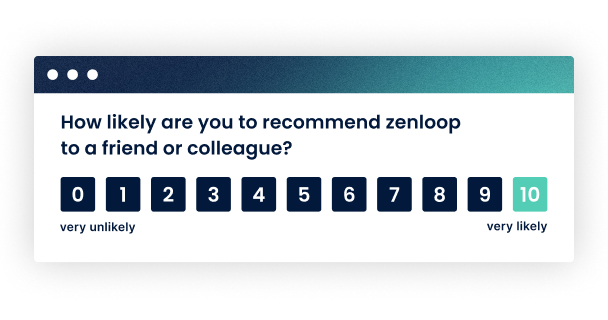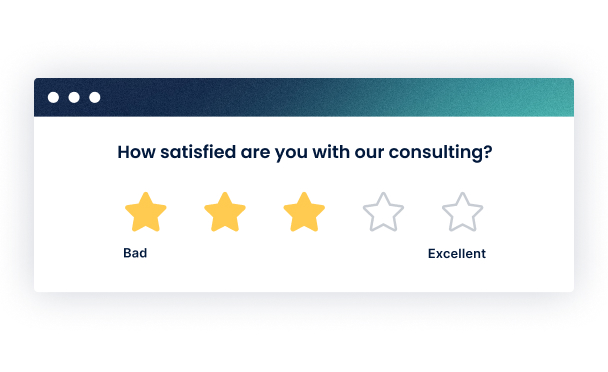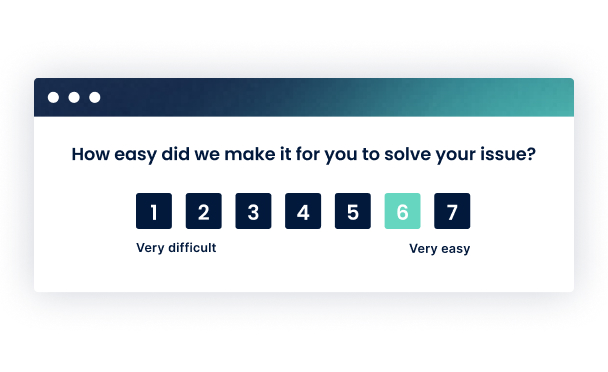Customer Surveys Done Right
A Guide to Customer Surveys
A company issuing a customer survey usually has two intentions: one is to receive feedback on products or services and the other is to increase customer retention. Funnily enough, companies which only set out to do the first usually also achieve the second, simply by virtue of dealing with and reacting to customer feedback. How so? Because they thereby signal that they care about their customers and their opinions.
Introduction
Customer surveys are key to understanding customer needs by providing qualitative and quantitative feedback. Companies can then use customer feedback to discover problem areas, identify churning customers, initiate measures to solve and improve products and services, and even win back departing customers. Customer surveys can therefore be used as a targeted marketing tool and represent an essential part of successful customer management.
Customer Survey Objectives
Customer surveys have long been a must-have on the marketing agenda. But in order for them to be effectual, their aim should be defined in advance. This is the most important step in planning a customer survey, because only when companies know what to measure will they ask the right questions.
As a general rule, asking customers for feedback means you want to know how satisfied they are with the company, product, or service. Most customer surveys, therefore, focus on measuring customer satisfaction. However, there are also other questions that are burning issues for companies, and recognizing these can provide starting points for the definition of your goals:
- What strengths and weaknesses do my customers see in the company?
- What do my customers know about products and services?
- How important do my customers consider individual product features?
- What does my typical customer look like? What are their characteristics and properties?
- What expectations and needs do my customers have?
- How can I improve customer contact and increase customer retention?
- How successful are my marketing and social media measures?
- How do customers rate my products and services?
Often the current situation determines the goals of a company. If, for example, extensive changes are pending, it can make sense to ask customers about the status quo and raise their expectations for the future. Several goals can also emerge during planning. Then it is advisable to carry out several customer surveys with different questionnaires. The survey participants also benefit from this: a short survey that only highlights one goal takes less time—and time is money, even among consumers. In addition, customer surveys deliver clearer and more unambiguous results if they only illuminate a partial aspect of the company.
In general, the objectives of a survey should be formulated in concrete detail and recorded in writing. This way, a success check is possible later on. The connection between costs and benefits of individual objectives should also not be ignored. If a goal turns out to be a cost sink, it should perhaps be left out.
Tips and Golden Rules for Customer Surveys
You have taken the first step: the goal is defined. Now it is time to implement it—but beware! These things do not always go according to plan. With the following tips, you can avoid the biggest pitfalls on the way to a successful customer survey and lay the foundations for your questionnaire.
1. Determine the Target Audience
Who should be interviewed? This question should be the start of your customer survey. Survey participants can vary depending on the objective. Should potential customers get asked for their feedback or rather customers who have not used your service for a long time? A survey among new customers will certainly bring different results to light than a survey among long-term loyal customers.
2. Formulate Questions Clearly
If you want clear answers, you have to ask clear questions. Questions that are vaguely formulated can cause misunderstandings among survey participants. This can mean that feedback is collected which has no meaningfulness for your goals. Add to this the following maxim: superficial questions provide superficial answers. Companies that ask their customers for details often receive higher quality and more meaningful answers and, therefore, better results.
3. Choose a Type of Interview
Whether by phone, verbally, in writing, by email, on the blog, or on the smartphone—there are many ways to conduct a customer survey and each has its own different advantages and disadvantages. The implementation not only determines the willingness of a participant to answer, but also the availability of customers and ultimately the results. Online surveys are still considered the silver bullet. It is important to decide on one type of survey and to stick to it consistently. Otherwise, the contents of differently conducted surveys are not always compatible with or even comparable to each other.
4. Keep an Eye on the Evaluation
When formulating the content and questions for the questionnaire, it makes sense to consider how much time is available for the evaluation. The evaluation of open questions usually takes longer because the answers are individual and cannot be easily graded. In the case of closed questions, for which only one scale value is marked, the evaluation is both easier and faster. Survey software can also shorten the evaluation considerably. The Net Promoter System® from zenloop, for example, automatically evaluates open answer fields with the help of Smart Labels.
5. Communicate Goals and Results
Customers are curious and often impatient. Companies should also contact their customers after the survey to let them know when they will publish the first results and what further steps are planned after the survey is completed. That ensures transparency. It can also be useful to state the objectives of the survey in advance. Companies that openly communicate the goal of their survey and do not rely on “Chinese Whispers” also gain additional trust. Your customers are then often more motivated to take part in the survey.
Forms of Customer Surveys
A look at different forms of customer surveys can provide valuable tips for your own. Surveys can be differentiated according to various criteria. The following list highlights the questions companies should keep in mind when preparing their next customer survey.
How many topics should the survey cover?
- One-dimensional customer surveys only focus on one topic. This form of customer survey enables companies to go into great detail on a specific topic. This can be customer service, for example. With one-dimensional customer surveys, companies can collect information that allows them to effectively plan specific changes.
- Multi-dimensional customer surveys usually cover several relevant topics. Therefore, this type of survey is particularly suitable for general customer satisfaction surveys and is the most widespread.
How many people should be interviewed?
- Full surveys are aimed at the entire customer base. Companies that want to receive the most extensive survey results possible should conduct this type of survey. The prerequisite for this, however, is that the customer base is manageable.
- Sample surveys (also partial surveys) concentrate on only a subsection of customers because only those are qualified to give an answer. Even with a large customer base or if not all participants are available, a partial survey can be a successful alternative. For example, companies can find out about their customer service by only asking those who have actually used it.
What is the reference point of the survey?
- In event-oriented customer surveys, the focus of the survey is on a specific event that took place in the relationship between the customer and the company. This could be the last visit to the website, for example. However, there is a risk here that this event is only a snapshot and not generally valid for the customer’s experience.
- Alternatively, the survey can relate to one or more features of a company’s product or service. In this case, we speak of feature-oriented customer surveys. They are usually more representative and therefore more valuable.
When should the survey be carried out?
- Ex-ante/ex-post surveys take place at two different times. As a rule, this is before the service provided or the product purchased and afterward. However, this form of survey is only suitable for services that have a clear beginning and end.
- With ex-post customer surveys, companies only ask for customer feedback once the service has been completed or the product has been purchased.
Customer Surveys Made Easy—with Sample Questions
Take it easy! There are still companies that suffer headaches when formulating suitable content and questions for their questionnaires. The Internet is teeming with numerous templates and examples that companies can use cheaply or even free of charge. Many templates are designed to target all types of potential customers. The tone, choice of words, and design of the questionnaire can be adapted to the company’s corporate identity with just a few quick clicks. Information on data protection can also be easily and individually added.
Short and Simple Instead of Long and Excessive
Many templates cause you to include too many questions in the survey. Although this is well-meant, it can quickly encourage the customer to click away. Companies should therefore not ask too many questions. A customer survey should take a maximum of ten to 15 minutes. 40 questions are the absolute limit, because the more extensive the survey, the lower the motivation is to participate.
The survey opening should also be chosen with care: in general, it is best not to try to tackle too much. A welcome message with a friendly greeting and the goal of the survey at the beginning can serve as a door opener. The participants feel encouraged to take part in the survey and, in the best-case scenario, this gives the company a head start in gaining customer confidence. However, companies should not jeopardize this goodwill when it comes to data protection. Here, too, the following applies: customers should be assured that their personal data is in good hands.
Ready to go? Then let’s get started. With the following sample questions, companies can create a successful questionnaire in next to no time:
The Most Common Customer Surveys
1. Referral Surveys
Customers who are satisfied with a company and its products are usually happy to recommend it to others. So why not ask customers about their willingness to recommend the company?
The Net Promoter Score® uses the relationship between recommendation, customer satisfaction, and customer loyalty by measuring it based on a single question:
“How likely are you to recommend our company or product to a friend or colleague?”
The participants give their answers to this question on a scale from 0 (not at all likely) to 10 (extremely likely).

2. Customer Satisfaction Survey
How do customers rate companies in general? Questions about the satisfaction or dissatisfaction of customers help companies with their self-assessment and reveal the potential for improvement.
“How satisfied are you with our company generally?”
The answers can be marked on a five-point scale with the following scale values: very satisfied – somewhat satisfied – not really satisfied – rather unsatisfied – very unsatisfied.

3. Survey on Effort
How complex do customers find an interaction with the company? The CES (Customer Effort Score) provides information on this. For example, it can be used to determine the effort required to complete an order or to reach customer service.
“How complex was the processing of your request? or How much effort did you have to put into processing your request?”
The answers are usually shown on a seven-point scale. However, scales of three or five digits are also possible. Depending on the question, these range from very complex to no problem or from very little to very much.
Another way that has recently developed is to ask customers if they agree or disagree with statements about what they experienced. Examples are:
“The company made it easy for me to reach customer service. or The company made it easy for me to process my request.”
Since approval is asked for in this case, the seven-point scale usually looks like this: I fully agree – I agree – I tend to agree – I neither agree nor disagree – I tend not to agree – I disagree – I completely disagree.

Further Options for Customer Surveys
4. Customer Loyalty Survey
If sales figures drop, companies don’t have to increase their marketing budget to acquire new customers. It is rather than advisable to turn attention to long-term regular customers and to bind these more strongly to the company. Anyone who asks early on about the loyalty of their customers is spared spontaneous waves of churn and can react to them in advance.
“How likely is it that you will buy from us again or use our services?”
The following values can be used to indicate whether a customer will remain loyal to a company in the future: very likely – likely – undecided – rather unlikely – very unlikely.
5. Product/Service Offerings Survey
How do customers perceive a company’s products or services? Surveys on products or services can reveal hidden discrepancies, for example, if the product design does not meet customer expectations. Market research in particular benefits from this information.
“Which of the following words would you use to describe our product/service?”
The customer can submit his evaluation by choosing several answers from a list: indispensable – high quality – practicable – exceptional – inexpensive – overpriced – conservative – cool – inferior – unreliable.
6. Need Satisfaction Survey
Does the product meet the customer’s needs? With the question of the satisfaction of needs, companies can find out to what extent a product or service meets the wishes and requirements of their customers.
“How well did our product or service meet your needs?”
The customer can rate his opinion on the following response scale: very well – quite well – not really – not well at all.
7. Product or Service Quality Survey
The question of the satisfaction of needs can be narrowed down even further. For example, companies can directly ask their customers about the quality of their products or services. This gives you an insight into whether the quality of the product or service meets the expectations of the customers and also the expectations of the company.
“How would you rate the quality of our product/service?”
Here, too, customers can share their feedback on a five-point scale with the following values: very high quality – high quality – average quality – low quality – very low quality.
8. Value for Money Survey
If companies have already collected initial feedback on the quality of their products or services, it can be helpful to take a closer look at pricing—especially when feedback on quality is positive but sales are falling. Companies can use the following question to ask their customers about their pricing policy:
“How do you rate the price-performance ratio of our product/service?”
The following adjectives can serve as possible answers and can be expanded as required: inexpensive – reasonable – average – expensive – overpriced.
9. Accessibility Survey
How satisfied customers are, does not only depend on a company’s products or services. Sometimes it is the trappings that open customers’ hearts. This is mainly reflected in the service and availability of a company.
“How available was our team for you with regard to questions and concerns about our product or service?”
Customers can give their feedback on the following scale: very easy to reach – easy to reach – generally reachable – difficult to reach – very difficult to reach.
Alternatively, companies can also ask customers about their satisfaction with their opening or support times.
10. Survey on the Duration of the Business Relationship
Companies that want to draw conclusions from customers about their answers can ask about the length of the business relationship. Is the participant a permanent or new customer? The answers can be used, for example, to see whether long-term customers are more satisfied than new customers. At the same time, it becomes clear whether new customers perceive and evaluate products or services differently than long-term loyal customers.
“How long have you been using our company’s products or services?”
The response scale contains various time spans that help the customer with the classification. They can be varied depending on the company: I’m not a customer yet – this is my first purchase – less than six months – six months to a year – one to two years – three years or more.
Room for Comments
An open answer field at the end of the survey gives participants the opportunity to leave additional information and suggestions that were not taken into account in the survey. Often these answers are real feedback gems that can be used for further product developments or marketing activities. As part of the Net Promoter Score, these answers provide valuable information as to why a customer would recommend the company or not.
What would a survey be without its participants? A short “thank you” should always be at the end of every survey. It expresses appreciation for the customer. If you personalize the thank you email with the name of the responsible department head, you can further strengthen the customer relationship.
Related:
Conduct customer surveys with zenloop






